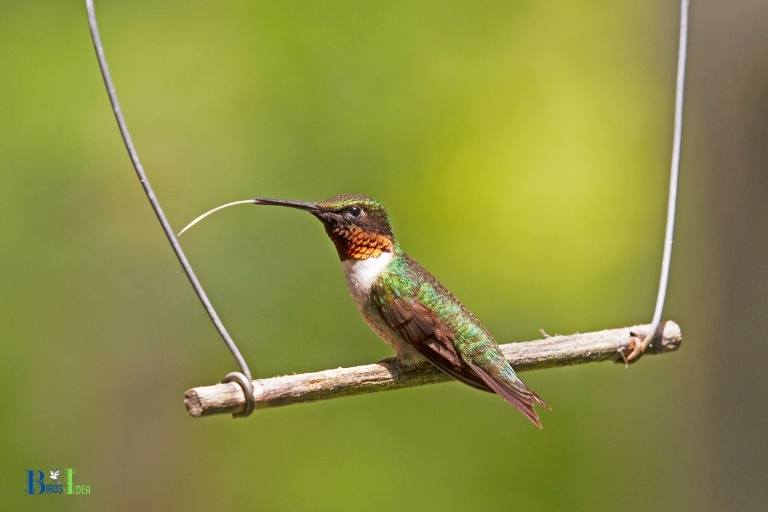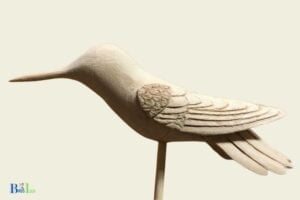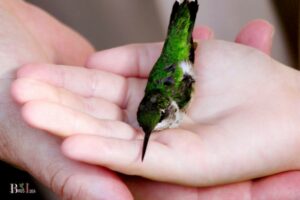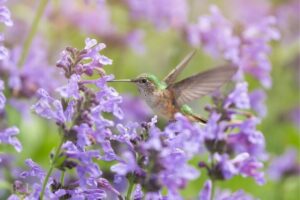How to Hang a Hummingbird Swing: Simple Guide!
To hang a hummingbird swing, select an appropriate location near a feeder or flower bed, mount the swing using a sturdy hook or branch, and ensure that it is secure and stable.
A hummingbird swing is a small perch designed for hummingbirds to rest and enjoy their surroundings.
Hanging a hummingbird swing near a feeder or flower bed is an excellent way to attract these fascinating birds to your garden and provide them with a resting spot.
Following a few simple steps will ensure that your hummingbird swing is properly installed and ready for its attractive visitors.
Mount the swing using a sturdy hook or branch for stability and durability. Make sure that the swing is secure and stable by tugging on it to test its strength.
Once your hummingbird swing is securely hung, observe and enjoy the visiting hummingbirds as they take a break from their busy day of feeding and pollinating.
8 Step-by-Step Guide to Hang a Hummingbird Swing
| Step | Description |
| 1 | Choose a location |
| 2 | Purchase or create a hummingbird swing |
| 3 | Assemble the swing if necessary |
| 4 | Attach a hook or S-hook to the swing’s top loop |
| 5 | Hang the swing from a branch, shepherd’s hook, or other suitable hanger |
| 6 | Adjust the swing height for optimal viewing |
| 7 | Place a hummingbird feeder nearby to attract hummingbirds to the swing |
| 8 | Observe and enjoy your new hummingbird swing |
Key Takeaway

Five Facts About: Hummingbird Swings
What Is A Hummingbird Swing And Why Hanging It Is Important
Have you ever wanted to get up close and personal with hummingbirds in your backyard? Hanging a hummingbird swing is a simple way to attract these beautiful and fascinating creatures.
But what exactly is a hummingbird swing?
Introduction To The Hummingbird Swing
A hummingbird swing is a small decorative perch with a hanging mechanism designed for hummingbirds. These swings mimic the swaying motion of a tree branch, which captivates hummingbirds and encourages them to linger and feed nearby.
They come in a variety of shapes, designs, and colors, ranging from simple wooden swings to intricate glass orbs.
Purpose Of Hanging A Hummingbird Swing
Hanging a hummingbird swing serves two primary purposes:
- Attracting hummingbirds: A hummingbird swing can be a welcome addition to any outdoor space. The swaying motion of the swing can attract hummingbirds to your yard, providing an up-close and personal opportunity to observe these tiny creatures.
- Providing a resting spot: Hummingbirds are tireless creatures that require frequent rest intervals. A hummingbird swing provides a safe and comfortable resting spot for these delicate birds, allowing them to take a break from their fast-paced flight routines.
Benefits Of Hanging A Hummingbird Swing
There are several benefits to hanging a hummingbird swing in your yard.
Here are a few notable ones:
- Affordable: Hummingbird swings are a cost-effective way to attract hummingbirds to your yard without breaking the bank.
- Low maintenance: Unlike bird feeders, hummingbird swings require no cleaning or refilling, making them low maintenance.
- Aesthetic appeal: Hummingbird swings are available in a variety of colors and designs, making them a beautiful addition to any outdoor space.
- Education: Hummingbird swings can be an excellent way to introduce children to the world of bird watching and nature.
- Eco-friendly: Hanging a hummingbird swing is an eco-friendly way to attract these birds, as it does not require the use of harmful chemicals or artificial means to lure them.
Hanging a hummingbird swing is a simple yet effective way to enjoy the beauty of these fascinating creatures up close.
By providing a comfortable resting spot and swaying motion, you can attract hummingbirds and enhance your outdoor space’s aesthetic appeal.
So why not give it a try today and see for yourself the wonders of hummingbirds’ up close and personal presence in your yard.
Tools And Materials Required For Hanging A Hummingbird Swing
Tools Required For Hanging A Hummingbird Swing
Hanging a hummingbird swing is an easy task that requires some tools.
Here are some necessary tools you will need to get started:
- A hummingbird swing
- A sturdy hook or branch to hang the swing
- A measuring tape or ruler to measure the distance
- A small level to ensure the stability of the swing
- A screwdriver for securing the hook or the branch
Best Materials For Hanging A Hummingbird Swing
Choosing the right materials is essential for the longevity and stability of the hummingbird swing.
Here are some of the best materials you can use to hang your hummingbird swing:
- Metal or plastic hooks are durable and can support the weight of the swing and the birds.
- Tree branches can be used for a more natural look, but make sure the branch is sturdy enough to hold the swing and remains secure.
- Nylon or twine ropes are lightweight, weather-resistant, and gentle on the tree branches.
- Stainless steel chains are strong and resistant to rust, making them another great option for hanging the hummingbird swing.
Choosing The Right Location For Hanging The Hummingbird Swing
Hummingbird swings should be placed in a location that is safe and attractive to hummingbirds.
Here are some tips on how to choose the right location for hanging the hummingbird swing:
- Hang the swing near a nectar-bearing plant to attract hummingbirds.
- Ensure that the location offers some shade and shelter from the sun and wind.
- Try to place the swing in an area that is visible to you to observe the birds.
- Ensure that the swing is not placed near bird feeders or in high traffic areas.
- Avoid placing the swing near windows or glass doors; they can be dangerous for the birds in case of collisions.
Hanging a hummingbird swing is a simple task that requires some tools and thoughtfulness in choosing the right location and materials.
Follow the tips mentioned above, and you will have a beautiful and safe place for hummingbirds to rest and play in your garden.
Step-By-Step Guide To Hanging Your Hummingbird Swing
Preparing To Hang Your Hummingbird Swing
Before you start with the installation process of your hummingbird swing, make sure you have everything you need.
Here are a few essential tips to help you have everything in place:
- Choose the right spot for the feeder. You’ll want it somewhere you can watch it while still maintaining a safe distance.
- Have a hook or branch that can support the weight of the feeder.
- Gather your tools: A drill, hooks or chains for hanging, screws, a level, and a measuring tape.
Choosing The Right Type Of Branch Or Hook For Your Swing
Choosing the right branch or hook might seem easy, but there are a few things you should keep in mind:
- Choose a thick and sturdy branch that’s at least five feet above the ground. This way, the swing will be further away from potential predators.
- Alternatively, choose a hook that can hold the weight of the feeder. A sturdy metal hook is a great option.
- Whatever you choose, make sure it’s located near a tree or other structure, such as a fence, where hummingbirds can quickly fly to and from the feeder.
Installing The Branch Or Hook In A Safe Way
Now that you have everything ready let’s get started with the installation process.
Here’s what you need to do:
- Determine the placement of your branch or hook. You need to ensure that there’s enough clearance around the feeder.
- Using your drill, make a small hole where you want to insert the hook or screw. Stop before the tip goes all the way through the branch (or wall).
- Insert the hook, screw, or branch. Be careful not to crack or damage the branch or wall.
- Use a level to make sure that the swing will hang straight.
Hanging The Hummingbird Swing Properly
Now Comes The Fun Part, Placing Your Hummingbird Swing!
- Take off the packaging and attach the hummingbird swing to the hook or chain.
- Adjust the swing so that it hangs level. Make sure that it is not swaying too much.
- Fill the hummingbird swing with nectar, and enjoy watching them come to feed.
Remember, hummingbirds are skittish, and they will need time to get used to the feeder. Don’t worry if it takes a few days for them to discover and start using the swing. With patience, you’ll have hummingbirds visiting in no time.
Congratulations, You Now Know How To Hang Your Hummingbird Swing!
Tips For Maintaining Your Hummingbird Swing
Hanging a hummingbird swing can be a delightful addition to your garden. It can provide a tranquil spot for these beautiful birds to rest and fuel up, while also offering fantastic views for human observers.
If you’re new to hummingbird swings, you may be wondering how to maintain your new garden addition.
With that in mind, here are some essential tips for maintaining your hummingbird swing.
Cleaning Your Hummingbird Swing To Keep It Functional
Hummingbirds are amazing creatures, but they can also be quite messy, with their frequent perching and feeding creating a buildup of dirt and debris on your swing.
Regular cleaning is essential to ensure that your swing stays functional as well as clean.
Here are some tips to ensure your hummingbird swing stays clean:
- Remove the hummingbird swing from its hanger carefully.
- Clean the swing with a diluted mixture of soap and water or a mixture of vinegar and water.
- Use a scrub brush gently to clean the swing.
- Rinse the swing thoroughly with a hose.
- Dry the swing with a soft towel before rehanging it.
When To Replace Your Hummingbird Swing
While hummingbird swings are durable and can withstand most weather conditions, they do eventually wear out. Over time, exposure to the elements, use, and even bird droppings can all take their toll on your hummingbird swing.
Here are some signs that it’s time to replace your hummingbird swing:
- Rust or corrosion on the metal parts of the swing.
- The rope or chain that holds the swing appears frayed or is starting to show signs of wear and tear.
- The wooden parts of the swing are splintered or have started to warp.
Avoiding Common Mistakes While Hanging And Maintaining Your Hummingbird Swing
Hummingbird swings can be tricky to hang and maintain, but it’s worth the effort to ensure that your hummingbirds have a safe and welcoming resting spot.
Here are some common mistakes to avoid while hanging and maintaining your hummingbird swing:
- Hanging the swing too close to feeders, as this can cause territorial issues among the birds.
- Hanging the swing too low, making it easier for predators to attack your hummingbirds.
- Forgetting to clean your hummingbird swing regularly can hamper its functionality.
- Neglecting to replace your hummingbird swing when it becomes worn out can result in a dangerous situation for the birds.
Hummingbird swings are an excellent addition to any garden, but they require some effort to maintain. By following the tips outlined above, you can ensure that your bird swing remains a cherished spot for hummingbirds to rest and refuel.
FAQ Of How To Hang A Hummingbird Swing
How Do I Choose A Hummingbird Swing?
Where Do I Hang My Hummingbird Swing?
How High Should I Hang My Hummingbird Swing?
How Do I Attract Hummingbirds To The Swing?
Can I Leave My Hummingbird Swing Out All Year?
Conclusion
Hanging a hummingbird swing can be a fun and rewarding experience for bird lovers. By following the steps outlined in this post, you can create a safe and comfortable space for hummingbirds to rest and observe their surroundings.
Remember to choose a sturdy branch or hook, and to hang the swing at the right height for hummingbirds to easily access it.
You can also experiment with adding the right type of nectar and other attractants to your yard, to create an even more inviting environment for these amazing creatures.
With these tips, you’ll be able to enjoy watching hummingbirds up close, while providing them with a cozy spot to relax and take a break from their busy lives.
So, put on your diy hat, and get ready to make your backyard a paradise for hummingbirds!






